How Often Dentists Refer TMD Patients to Physical Therapists?
According to survey conducted by researchers at the physical therapy department, Florida International University, a large percentage of dentists was unaware of the benefits of physical therapy in treating tempromandibular disorder (TMD) pain. This survey was successful in increasing the awareness level of the surveyed dentists in Florida toward how important physical therapy is for treating TMD patients. Most of the surveyed dentists (80%) showed interest to understand more about the benefits of a multidisciplinary approach between physical therapists and dentists to help TMD patients.
This was the first study to evaluate the awareness of dentists in Florida about the importance of the multidisciplinary approach with physical therapists for pain management with TMD using an online questionnaire. The response rate was very low but had some relevant information about the current level of awareness among the participants. That is, 88 surveyed dentists had never referred a TMD patient to physiotherapy, and 74% of this number was unaware of the benefits of physical therapy in TMD. However, 81% of surveyed dentists are more likely to refer a TMD patient to physical therapist after taking this survey. Almost one-third of the surveyed dentists do not regularly evaluate their TMD patients for poor head and neck posture or for other headache or neck pain.
It is clearly evident that dentists should be sum up these disorders in their patients in order to refer their patients for appropriate physical therapy or pain management clinics. In addition, dentists must inspect tooth-related pain, dental occlusion problems related to TMD or parafunction habits which could be treated with dental splint. Patients can be advised to exercise their masticatory muscles with soft tissue massage or hot fomentation.
A previous study showed that patients who receive a combination of dental splint therapy and physical therapy could achieve greater range of motion and pain relief than splint therapy alone.

It is worth mentioning that 62% of surveyed dentists in the above study refer TMD patients to oral surgeons for TMJ surgery. However, previous studies also showed that a presurgical physical therapy can also optimize the outcomes of surgery. The highest percentage of dentists who refer TMD patients to physical therapists was found to be among orthodontists (55%)
Almost 32% of dentists who participated in this survey were unaware of the relationship between cervical spine and orofacial symptoms. Cervical spine postural reeducation is a common recommendation for patients with TMD patients combined with manual therapy and jaw exercises.
Behavioral therapy is also an integral part of TMD therapy; patients’ behavior can be modified by seminars or lectures given by a multidisciplinary team of dentists, physical therapists pain-management specialists and even psychiatrists if needed.

